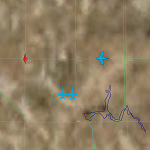-
electronic_warfare¶
Electronic Warfare Demos¶
|
|
Electronic Warfare Test Tool Examples¶
Electronic warfare consists of Electronic Attack (EA) and Electronic Protect (EP), each consisting of multiple techniques.
These techniques are discussed briefly with a link to a simple example file demonstrating the corresponding technique in
the Test Tool. Then a category of miscellaneous examples is discussed.
Electronic Attack (EA)¶
EA is the utilization of electronic devices to trick or deceive electronic sensors. EA is comprised of general factors
and effects. The general factors combine with zero or more effects to achieve the overall desired Effective Radiated Power (ERP).
* General Factors
Power, frequency, and bandwidth are the general factors of EA. Depending on the relative values of these factors and
the emitter under attack the attack may be considered barrage or spot jamming.
* Barrage Noise Jamming
A barrage noise jamming attack is the transmitting of a large frequency band with respect to an emitter’s bandwidth.
Barrage noise jamming can be accomplished with multiple jammers on adjacent frequencies, a single wideband transmitter,
or a transmitter capable of frequency sweep fast enough to appear radiating simultaneously over wide band.
barrage_jammer.txt (single wideband transmitter)
* Spot Noise Jamming
The transmitting of a small frequency band with respect an emitter’s bandwidth is considered spot noise jamming.
spot_jammer.txt
agile_jamming.txt
..\iads_demo\platforms\soj.txt
..\aea_demo\platforms\soj.txt
* Technique Effects
Any one or more of the following effects can be used with the general factors above to further describe the overall EA
effect. Random Pulse Jamming and False Target Jamming effects are developed for a specific technique to simplify the user inputs.
Delta Gain and Track Error are general purpose effects. These effects allow for the modeling of future and/or unknown techniques
where only the effect is understood or in a design role to determining desired effects for a given scenario outcome.
* Random Pulse Jamming (RPJ)
RPJ is the EA technique of transmitting random pulses of noise.
rpj_jammer.txt
..\aea_demo\weapons\soj_base_jammer.txt
* False Target Jamming
An EA technique of deception, False Target Jamming creates the perception of false targets to tracking systems causing them to break lock.
..\aea_demo\weapons\soj_base_jammer.txt
- Pulse Density Based
False target are introduced to an emitter based on the pulse density.
false-target_jamming_1.txt
- Constrained
False target range to emitter is not less than jammer range to emitter.
false-target_jamming_2.txt
- Random
False targets are random from scan to scan.
false-target_jamming_2.txt
false-target_jamming_3.txt
* Delta Gain (jamming improvements)
Delta Gain (jamming improvements) is the general purpose EA effect on an emitter’s gain of the jamming signal.
spot_jammer.txt
* Track Error Inducement
Track Error Inducement is the general purpose EA effect on an emitter’s perceived tracks accuracy.
<track_error.txt>
..\aea_demo\weapons\soj_base_jammer.txt
Electronic Protect (EP)¶
EP is the utilization of electronic devices to reduce or eliminate the effect of EA on electronic sensors.
* Sidelode Blanker (SLB)
SLB uses an auxiliary omnidirectional antenna to ignore the main antennas signal when the auxiliary antenna’s signal is larger.
The auxiliary typically has a larger gain than any of the main antennas sidelobes. Thus during successful jamming the radar
will be blank expect for the direction of the jammer, thus rendering the direction of jamming as the only useful information.
rpj_jammer.txt
false-target_jamming_1.txt
false-target_jamming_2.txt
false-target_jamming_3.txt
..\iads_demo\sensor\ew_radar.txt
..\aea_demo\sensor\ew_radar.txt
* Sidelobe Canceller (SLC)
Similar to SLB except through additional circuitry the direction of jamming is used to cancel its effect through the scan
cycle rather than blanking the main antennas signal. Thus re-enabling target detections off angle of jamming.
barrage_jammer.txt
spot_jammer.txt
..\aea_demo\sensor\ew_radar.txt
* Pulse Suppression
* Agility
Agility is the rapid switching of the transmitted frequency and receiving only that frequency during the receiving time window.
agile_jamming.txt
..\aea_demo
* Delta Gain (jamming reduction)
A Delta Gain (jamming reduction) compensates jamming improvements of a Delta Gain EA effect.
spot_jammer.txt
* Track Error Mitigation
A Track Error Mitigation compensates track errors from a Track Error Inducement effect.
<track_error.txt>
..\aea_demo
Other (scripting/scenario/fusion/correlation)¶
* Open Loop Jamming Assignment
Open Loop Jamming occurs without the perception of an emitter.
spot_jammer.txt
* Closed Loop (ESM Based) EW Selection
Jamming based on the perception of an emitter.
agile_jamming.txt
..\iads_demo\platforms\soj.txt
..\aea_demo\weapons\soj_base_jammer.txt
* DIS Jamming
<dis_jammer_1>
<dis_jammer_2>
* Command Center Correlation/Fusion
false-target_command_center.txt
* False Target sensor detect/track plotting capability
Allows for the plotting of detect and track events (not-detecting, detecting, tracking) via the observer and gnuplot
plotting file. Creates 4 files, one replay file and three *.dat files containing the data for no-detect, detect
and tracking.
<ft_track-plot.txt> & <ft_track_plot.gnu> use gnuplot with command >load “ft_track_plot.gnu” to plot output.


